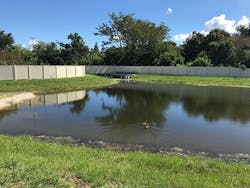Real Estate Development Meets Regulatory Requirements
According to the Southwest Florida Water Management District (SWFWMD), “Tampa Bay is divided into seven major bay segments. The Old Tampa Bay watershed is about 250 sq miles and encompasses northwest Hillsborough and central Pinellas counties…. Largo, Fla., is centrally located in Pinellas County, touching the Intercoastal Waterway to the southwest and Tampa Bay to the northeast. Largo began as a rural farming community and became the third-largest city in Florida’s most densely populated county and the fourth largest city in the Tampa Bay area.”
Situation
“Over the last 50 years, the land has transitioned from natural habitat to primarily urban development, negatively impacting the water that ultimately reaches Old Tampa Bay." Wetlands, mangroves and open porous land that have historically provided Pinellas County’s waterways with natural filtration have declined rapidly. Surfaces that are impervious to rain and storm water infiltration (or absorption) now blanket green areas and begin to contribute to “source points” of waterway pollution.
Floridians have already seen signs of escalating concern, as issues begin to compound and negatively affect the health of their local environment, wildlife and tourism. The most obvious signs are large-scale algae blooms caused by rising shoreline nutrient concentrations—predominantly nitrogen and phosphorus. “Recent studies and recurring algae blooms in the upper portions of Tampa Bay over the last few years have indicated the need for a localized assessment…. The SWFWMD and the Tampa Bay Estuary Program developed a program to determine the primary factors leading to the declining water quality and habitat conditions observed in Old Tampa Bay.”
According to the Florida Department of Environmental Protection, “Storm water runoff picks up pollutants like trash, chemicals, oils and dirt/sediment that can harm our rivers, streams and lakes. To protect these resources, municipalities, construction and industries activities (and others) use storm water controls, known as best management practices (BMPs), to manage their runoff. The implementation of these practices, which include BMP design, performance and adaptive management requirements, prevent pollution by controlling it at its source.”
Challenge
SWFWMD is “actively involved in maintaining and improving the water quality within its boundaries.” It plays a massive managerial role in approving the implementation of storm water treatment systems to mitigate point source pollution as part of the program now in place in Pinellas County. Some of these systems include proven BMPs and efficient storm water systems that successfully have saved thousands of watersheds throughout the country and now are being deployed in Florida’s coastal communities.
The Orange Blossom Townhome project in Largo is one notable development in this expanding part of Florida. Set to install 55,601 cu ft of impervious surface, the site’s design involved drainage systems that would divert sheet flows collecting hazardous nitrogen and phosphorus pollutants away from two wetland conservation areas and toward two manmade storm water ponds.
Water from these ponds eventually would flow into the downstream “Wetland Conservation Area 1,” or retention pond, but not before a reliable and effective pretreatment BMP treated the polluted water. SWFWMD required the site’s pretreatment device to remove 76% of nitrogen and 67% of phosphorus prior to discharging into a wetland conservation pond and required a drain-down time of 36 hours. (Before 36 hours, the storm water system must have no remaining standing water).
Solution
“Wetlands are Florida’s original storm water systems and once covered more than half the state. Unfortunately, because people once misunderstood the true value of wetlands, more than one-half of our original wetlands have been drained for agriculture or filled for roads, housing developments and industrial complexes.”
Bio Clean understands the loss of this natural resource and has spent years returning this valuable part of nature’s cleaning system back to the environment—and now Florida’s coastal communities—through an innovative and cost-effective technology called the Modular Wetlands system. This is a biofiltration system that utilizes horizontal flow to accomplish a number of superior conveniences that benefit the environment and landowners (or developers) looking for cost-effective advantages. Florida’s Old Tampa Bay will see long-term benefits from the system’s proven ability to remove 76% of the nitrogen and 67% of the phosphorus present in this residential development’s storm water runoff.
Modular Wetlands provides a number of beneficial features that are crucial to Florida’s fight against high coastal nutrient levels. The system has multiple stages of treatment that give it superior capacities and maintenance efficiencies. When it comes time to clean the system out, trapped pollutants have been compartmentalized in an easy-to-access pretreatment chamber and are cleaned with a typical vacuum truck. The horizontal flow design allows the system to efficiently provide the same treatment as other systems with a smaller footprint. So while landowners and managers enjoy long-term low maintenance costs, developers benefit from low excavation and construction costs.
Additionally, during extreme rain events, water volumes can increase abnormally, causing some typical downward flow systems to fail as they get overwhelmed. As they fail, they release pollutants they already have collected into downstream rivers, tributaries and the bay. In the Modular Wetlands system, this hazard is avoidable. Horizontal flow allows for internal high-flow bypass—the system’s side-by-side orientation design—placing the pretreatment and discharge chambers adjacent to one another. This design allows high flows to bypass the main biofiltration chamber internally, keeping previously collected pollutants trapped—a powerful pollution safeguard in heavy rain states such as Florida and the rest of the southeast.
[Visit Bio Clean’s SWS Storefront]
Wetlands will always be a vital part of Florida’s storm water treatment, and Bio Clean’s Modular Wetlands system will continue to provide communities with a confident solution to continually protect Florida’s shorelines, environmental health and beauty.


